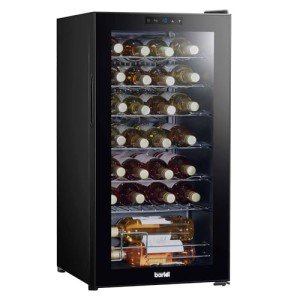How To Know If You're Prepared To Fridges And Freezers

Understanding Fridges and Freezers: The Essential Kitchen Appliances
Refrigerators and freezers are 2 of the most necessary appliances in modern-day kitchens. These appliances serve an essential role in food conservation and waste decrease by guaranteeing that disposable products remain fresh and safe for intake. This article delves into the numerous kinds of fridges and freezers, their functionalities, and crucial factors to consider for selection and upkeep.
Kinds of Refrigerators
The marketplace offers a variety of refrigerator types, each developed to satisfy various consumer requirements. Below is a list of the most common types of fridges:
Top-Freezer Refrigerators
- Most common type.
- Freezer compartment lies above the refrigerator area.
- Normally more affordable and energy-efficient.
Bottom-Freezer Refrigerators
- Freezer lies at the bottom.
- Allows much easier access to fresh products at eye level.
- Frequently includes pull-out drawers for much better company.
Side-by-Side Refrigerators
- Refrigerator and freezer sections are nearby.
- Perfect for narrow kitchen areas and permits simple access to both compartments.
- Typically includes water and ice dispensers.
French Door Refrigerators
- Integrates a bottom freezer with double doors at the top.
- Deals adequate storage and elegant designs.
- Typically consists of functions like temperature-controlled drawers.
Compact Refrigerators
- Smaller size perfect for restricted spaces.
- Typically utilized in dorm spaces, studio apartments, or as secondary fridges.
Table 1: Comparison of Refrigerator Types
| Type | Benefits | Drawbacks | Normal Size |
|---|---|---|---|
| Top-Freezer | Cost effective, energy-efficient | Less convenient access to the freezer | 14-30 cu. ft. |
| Bottom-Freezer | Much easier access to fresh food | Freezer can be more difficult to organize | 19-30 cu. ft. |
| Side-by-Side | Easy gain access to, water/ice dispenser | Narrow vs. storage area | 22-30 cu. ft. |
| French Door | Trendy, large, organized | More expensive | 20-30+ cu. ft. |
| Compact | Space-saving, portable | Limited storage | 1.7-5.5 cu. ft. |
Types of Freezers
Freezers are an equally important appliance for food preservation. They are available in numerous designs created to fit different family requirements. Think about the list below types:
Upright Freezers
- Run like a basic refrigerator with vertical storage.
- Simpler to organize with racks and compartments.
Chest Freezers
- Large, horizontal style generally using more storage space.
- Maintains temperatures better during power blackouts.
- More energy-efficient than upright designs.
Portable Freezers
- Compact units perfect for outside activities or little spaces.
- Typically utilized for camping journeys or as short-lived storage.
Table 2: Comparison of Freezer Types
| Type | Advantages | Drawbacks | Normal Size |
|---|---|---|---|
| Upright Freezer | Easier to arrange | Less energy-efficient, more floor space | 5-20 cu. ft. |
| Chest Freezer | Holds more items, energy-efficient | Harder to organize | 5-25 cu. ft. |
| Portable Freezer | Compact and versatile | Minimal storage capability | 1-10 cu. ft. |
Key Features to Consider
When picking a fridge or freezer, customers need to remember numerous features that can boost performance:
- Energy Efficiency: Look for models with the ENERGY STAR accreditation to save money on electrical power costs.
- Storage Capacity: Evaluate storage requirements based upon family size and eating routines.
- Temperature level Control: Some devices offer digital controls for exact temperature settings.
- Adjustable Shelving: Customizable shelving enables for ideal company.
- Water and Ice Dispenser: Offers convenience however can take up valuable space inside.
- Sound Level: Sound ratings can influence comfort, specifically in open-concept homes.
Advantages and disadvantages of Having a Fridge and Freezer
While fridges and freezers are indispensable technologies, they likewise have particular benefits and disadvantages:
| Pros | Cons |
|---|---|
| Protect food life expectancy and lower waste | Need routine maintenance |
| Enable bulk purchasing and meal prepping | Can be pricey to purchase and run |
| Deal convenience and fast access to food | Occupy considerable kitchen area space |
Maintenance Tips
To make sure durability and optimum efficiency of fridges and freezers, think about the following maintenance tips:
- Regular Cleaning: Clean the exterior and interior regularly to avoid accumulation of dirt and germs.
- Inspect Seals: Inspect door seals frequently for leaks to preserve efficiency.
- Temperature Settings: Keep the fridge at 34-38 ° F and the freezer at 0 ° F for optimal food preservation.
- Thaw as Needed: Chest freezers ought to be defrosted frequently to keep efficiency.
- Clear Air Vents: Ensure that air flow isn't obstructed to improve energy efficiency.
FAQs About Fridges and Freezers
Q1: How long can food be stored in a freezer?A: Most foods can be kept in a freezer for numerous months. Cheap Fridges Freezers and poultry often last 4-12 months, while veggies can last up to 8-12 months.
Q2: How frequently should I clean my fridge and freezer?A: It is recommended to clean your fridge and freezer every 3 to 6 months, or as needed when spills happen. Q3: Can I put hot food directly in the fridge?A: It is suggested to cool hot food to room temperature level before positioning it in the fridge to prevent
raising the temperature level inside the home appliance. Q4: Why is my fridge running constantly?A: This could be due to a malfunctioning thermostat, clogged up coils, or door seals that aren't working properly. Fridges and freezers are indispensable
assets to modern homes, supplying important services for food storage and preservation.
Understanding the various types, features, and upkeep requirements can help consumers pick the best home appliances for their requirements and optimize their functionality. Embracing energy-efficient models not only supports sustainable practices but also contributes to significant cost savings on energy bills, making informed choices more crucial than ever.

